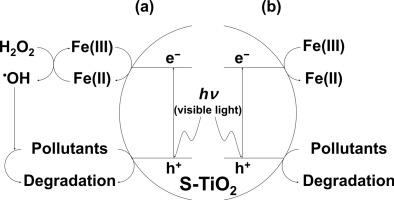Publication
Advanced Redox Technology Lab
Publication
Advanced Redox Technology Lab
Journal papers
Sulfur-doped TiO2 (S-TiO2) coupled with the Fenton-like reagent (i.e., Fe(III) and H2O2) exhibited photochemical activity under visible-light illumination, resulting in the degradation of over 95 % benzoic acid, 95 % carbamazepine, and 99 % 4-chlorophenol within 30 min. The combined system removed contaminants much faster than its uncombined S-TiO2/visible light and Fe(III)/H2O2 counterparts. The synergistic effect between S-TiO2 and the Fenton-like reagent was found to be due to 1) the generation of conduction band electrons and valence band holes in S-TiO2 under visible light illumination; 2) the reduction of Fe(III) by the conduction band electrons, thereby enhancing Fe(II) generation while minimizing electron-hole recombination; 3) the production of •OH from the reactions between Fe(II) and H2O2, and between H2O2 and conduction band electrons; and 4) the oxidation of contaminants by both valence band holes and •OH. Under the experimental conditions employed in this study, the S-TiO2/visible light/Fe(III)/H2O2 system exhibited a sustainable reactivity over 7 testing cycles, with more than 90 % of BA degraded in each cycle.
